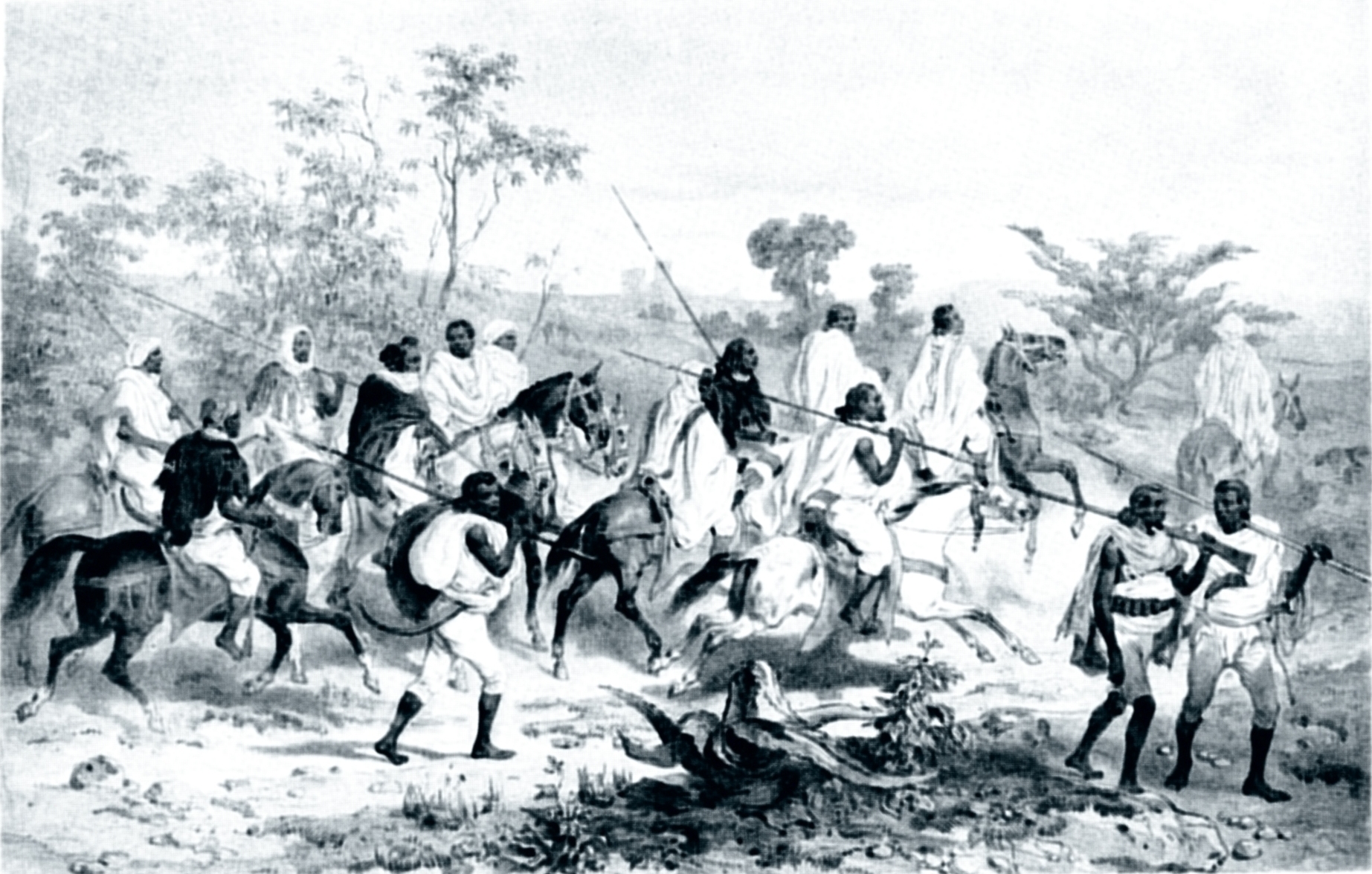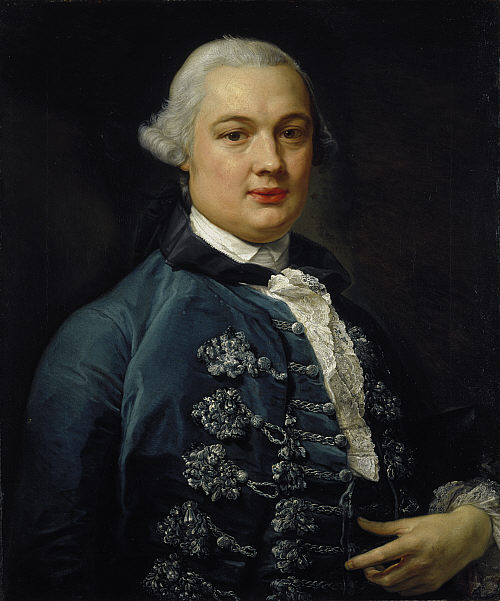|
Wand Bewossen
Dejazmach Wand Bewossen (died 10 December 1777) was a prominent figure in Ethiopian history. He was governor of Lasta and later Begemeder. He was on the losing side in the Battle of Nefas Mewcha (1769), but one of the victorious generals in the Three battles of Sarbakusa (May 1771). For his valor in the Battle of Faggeta (9 December 1769), which included pursuing Fasil for three days after the engagement, he was made governor of Begemder, as well as married to ''Woizero'' Ayabdar. He was also married to ''Woizero'' Yeworqweha, who was a descendant of Iyasu I and Woizero Wossen Azal, daughter of Dejazmatch Eshete Awsgenyos, sometime Governor of Agaw and Damot. Not long after his marriage to ''Woizero'' Ayabdar, Wand Bewossen desired to wed Wossen Azal, the sister of Hailu Eshte. Hailu would not consent to this marriage: according to Herbert Weld Blundell's translation Hailu considered this alliance bigamous, but Donald Crummy's interpretation of the Ge'ez text is Hailu was more ... [...More Info...] [...Related Items...] OR: [Wikipedia] [Google] [Baidu] |
Dejazmach
Until the end of the Ethiopian Empire, Ethiopian monarchy in 1974, there were two categories of nobility in Ethiopia and Eritrea. The Mesafint ( gez, መሳፍንት , modern , singular መስፍን , modern , "prince"), the hereditary nobility, formed the upper echelon of the ruling class. The Mekwanint ( gez, መኳንንት , modern , singular መኰንን , modern or am, መኮንን , "officer") were the appointed nobles, often of humble birth, who formed the bulk of the aristocracy. Until the 20th century, the most powerful people at court were generally members of the ''Mekwanint'' appointed by the monarch, while regionally, the ''Mesafint'' enjoyed greater influence and power. Emperor Haile Selassie greatly curtailed the power of the ''Mesafint'' to the benefit of the ''Mekwanint'', who by then were essentially coterminous with the Ethiopian government. The ''Mekwanint'' were officials who had been granted specific offices in the Abyssinian government or court. Higher r ... [...More Info...] [...Related Items...] OR: [Wikipedia] [Google] [Baidu] |
Hailu Eshte
Hailu (Amharic: ኃይሉ) is a male name of Ethiopian origin that may refer to: *Hailu Shawul (born 1936), Ethiopian engineer and the chairman of the Coalition for Unity and Democracy *Hailu Tekle Haymanot (1868–1950), Ethiopian army commander and nobleman *Hailu Mekonnen (born 1980), Ethiopian long-distance runner and two-time World Cross Country medallist *Aynalem Hailu (born 1986), Ethiopian footballer *Hailu Negussie (born 1978), Ethiopian marathon runner and 2005 Boston Marathon winner *Hailu Yimenu (died 1991), Ethiopian Prime Minister *Meseret Hailu (born 1990), Ethiopian female long-distance runner and world half marathon champion *Kassa Hailu (1818–1868), birth name of Ethiopian Emperor Tewodros II See also *Haifeng dialect of Hakka, also known as Hailu or Haiufeng *Haile (other) *Hailuoto Hailuoto (; sv, Karlö) is a Finnish island in the northern Baltic Sea and a municipality in Northern Ostrobothnia region. The population of Hailuoto is (), which make ... [...More Info...] [...Related Items...] OR: [Wikipedia] [Google] [Baidu] |
18th-century Ethiopian People
The 18th century lasted from January 1, 1701 (Roman numerals, MDCCI) to December 31, 1800 (Roman numerals, MDCCC). During the 18th century, elements of Age of Enlightenment, Enlightenment thinking culminated in the American Revolution, American, French Revolution, French, and Haitian Revolution, Haitian Revolutions. During the century, History of slavery, slave trading and human trafficking expanded across the shores of the Atlantic Ocean, Atlantic, while declining in Russian Empire, Russia, Qing dynasty, China, and Joseon, Korea. Revolutions began to challenge the legitimacy of monarchical and aristocratic power structures, including the structures and beliefs that Proslavery, supported slavery. The Industrial Revolution began during mid-century, leading to radical changes in Society, human society and the Natural environment, environment. Western historians have occasionally defined the 18th century otherwise for the purposes of their work. For example, the "short" 18th cen ... [...More Info...] [...Related Items...] OR: [Wikipedia] [Google] [Baidu] |
1777 Deaths
Events January–March * January 2 – American Revolutionary War – Battle of the Assunpink Creek: American general George Washington's army repulses a British attack by Lieutenant General Charles Cornwallis, in a second battle at Trenton, New Jersey. * January 3 – American Revolutionary War – Battle of Princeton: American general George Washington's army defeats British troops. * January 13 – Mission Santa Clara de Asís is founded in what becomes Santa Clara, California. * January 15 – Vermont declares its independence from New York, becoming the Vermont Republic, an independent country, a status it retains until it joins the United States as the 14th state in 1791. * January 21 – The Continental Congress approves a resolution "that an unauthentic copy, with names of the signers of the Declaration of independence, be sent to each of the United States. *February 5 – Under the 1st Constitution of Georgia, 8 counties are ... [...More Info...] [...Related Items...] OR: [Wikipedia] [Google] [Baidu] |
Zemene Mesafint
The Zemene Mesafint ( gez, ዘመነ መሳፍንት ''zamana masāfint'', modern: ''zemene mesāfint'', variously translated "Era of Judges," "Era of the Princes," "Age of Princes," etc.; named after the Book of Judges) was a period in Ethiopian history between the mid-18th and mid-19th centuries when the country was ruled by a class of regional noblemen and the emperor was merely a figurehead. For the most part, the regional lords were tightly related by marriage and constituted a stable ruling elite that prevailed until the mid 20th century. In short, during the Zamana Masafint, the Emperors from the Solomonic dynasty were reduced to little more than figureheads confined to the capital city of Gondar. The most powerful lords during the Zemene Mesafint were Ras Mikael Sehul of Tigre and later the Were Seh Dynasty who included Ras Ali I, Ras Aligaz, Ras Gugsa and Ras Ali II based in Yeju, a region in Wollo. . The most powerful lords such as Ras Ali and Ras Gugsa were memb ... [...More Info...] [...Related Items...] OR: [Wikipedia] [Google] [Baidu] |
Journal Of African History
''The Journal of African History'' (JAH) is a triannual peer-reviewed academic journal. It was established in 1960 and is published by Cambridge University Press. It was among the first specialist journals to be devoted to African history and archaeology and was founded by John Fage and Roland Oliver. As stated on the journal's website: The current editors are Professor Shane Doyle University of Leeds, UK', Professor Dan Magaziner Yale University, USA', Professor Marissa Moorman Indiana University Bloomington, USA', and Professor Moses Ochonu Vanderbilt University, USA'. Abstracting and indexing The journal is abstracted and indexed in: According to the official website, the journal has a 2015 impact factor The impact factor (IF) or journal impact factor (JIF) of an academic journal is a scientometric index calculated by Clarivate that reflects the yearly mean number of citations of articles published in the last two years in a given journal, as i ... of 0.857. Referen ... [...More Info...] [...Related Items...] OR: [Wikipedia] [Google] [Baidu] |
Herbert Weld Blundell
Herbert Joseph Weld Blundell (1852 – 5 February 1935) was an English traveller in Africa, archaeologist, philanthropist and yachtsman. He shortened his surname from Weld Blundell to Weld, in 1924. Life to 1922 He was educated at Stonyhurst College. He travelled to Persia in 1891, then for a decade 1894 to 1905 in North Africa and East Africa. He was a correspondent for the ''Morning Post'' during the Second Boer War. Expeditions included *1891-2 Persepolis, with Lorenzo Giuntini, making casts of the reliefs *1894-5 Libya and Cyrenaica, creating a photographic record *1898 Abyssinia Expedition with Lord Lovat and Reginald KoettlitzRichard Snailham" Europeans on the Blue Nile Region" Anglo-Ethiopian Society, 1992 (accessed 29 June 2009) *1904-5 Around Addis Ababa *1922 Weld Blundell Expedition, found the Weld-Blundell Prism, now in the Ashmolean Museum In 1921–1922 he presented the Weld Blundell Collection to the University of Oxford. From 1923 He backed a 1923 expedition ... [...More Info...] [...Related Items...] OR: [Wikipedia] [Google] [Baidu] |
Iyasu I
Iyasu I ( Ge'ez: ኢያሱ ፩; 1654 – 13 October 1706), throne name Adyam Sagad (Ge'ez: አድያም ሰገድ), also known as Iyasu the Great, was Emperor of Ethiopia from 19 July 1682 until his death in 1706, and a member of the Solomonic dynasty. Described as the last “great” Gondarine monarch, Iyasu temporarily halted the trend of decline through his brilliance as a military leader, reestablishing control over rebellious vassals and conquering areas to the south of his domain. In addition to his military and political exploits, Iyasu was a patron of architecture, arts and literature. He also attempted to settle doctrinal differences within Ethiopia’s Coptic Church, but without long-lasting success. Iyasu was deposed by his own son Tekle Haymanot I in 1706 and assassinated by the relatives of one of his concubines. A series of ineffectual emperors followed and imperial power declined until the advent of Tewodros II in the middle of the nineteenth century. Ancestr ... [...More Info...] [...Related Items...] OR: [Wikipedia] [Google] [Baidu] |
Ethiopia
Ethiopia, , om, Itiyoophiyaa, so, Itoobiya, ti, ኢትዮጵያ, Ítiyop'iya, aa, Itiyoppiya officially the Federal Democratic Republic of Ethiopia, is a landlocked country in the Horn of Africa. It shares borders with Eritrea to the north, Djibouti to the northeast, Somalia to the east and northeast, Kenya to the south, South Sudan to the west, and Sudan to the northwest. Ethiopia has a total area of . As of 2022, it is home to around 113.5 million inhabitants, making it the 13th-most populous country in the world and the 2nd-most populous in Africa after Nigeria. The national capital and largest city, Addis Ababa, lies several kilometres west of the East African Rift that splits the country into the African and Somali tectonic plates. Anatomically modern humans emerged from modern-day Ethiopia and set out to the Near East and elsewhere in the Middle Paleolithic period. Southwestern Ethiopia has been proposed as a possible homeland of the Afroasiatic langua ... [...More Info...] [...Related Items...] OR: [Wikipedia] [Google] [Baidu] |
James Bruce
James Bruce of Kinnaird (14 December 1730 – 27 April 1794) was a Scottish traveller and travel writer who confirmed the source of the Blue Nile. He spent more than a dozen years in North Africa and Ethiopia and in 1770 became the first European to trace the origins of the Blue Nile from Egypt and Sudan. Early life James Bruce was born at the family seat of Kinnaird, Stirlingshire, and educated at Harrow School and Edinburgh University, and began to study for the bar, but his marriage to the daughter of a wine importer and merchant resulted in him entering that business instead. His wife died in October 1754, within nine months of marriage, and Bruce thereafter travelled in Portugal and Spain as part of the wine trade. The examination of oriental manuscripts at the Escorial in Spain led him to the study of Arabic and Ge'ez and determined his future career. In 1758 his father's death placed him in possession of the estate of Kinnaird. To North Africa On the outbreak of war ... [...More Info...] [...Related Items...] OR: [Wikipedia] [Google] [Baidu] |




